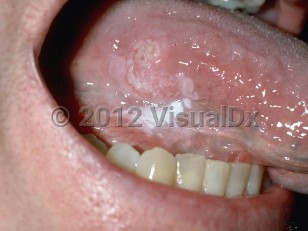Oral squamous cell carcinoma - Oral Mucosal Lesion
Alerts and Notices
Important News & Links
Synopsis

However, of increasing importance is the development of oral SCC in patients who are immunocompromised or on chronic immunosuppression such as organ transplant recipients, patients with a history of cancer of any type, and patients with a family history of cancer of any type. Other risk factors include the use of areca nut in all its variations (eg, betel paan in India). Patients who develop submucous fibrosis from chewing areca nut in its various forms are at high risk for developing SCC. More recently, human papillomavirus (HPV), in particular HPV-16, has been implicated in the development of SCC of the tonsil, oropharynx, and sometimes base of tongue. HPV-associated symptoms may have a latency of 10-30 years after oral sex exposure.
Most patients are between the ages of 50 and 70 at the time of diagnosis, although teenagers may be affected. Males are affected twice as frequently as females.
Oral SCC is generally asymptomatic in its early stages. Eventually patients will complain of tenderness, pain or numbness associated with the lesion. Depending on the location and size of the lesion, dysphagia or dysphonia may be present. Systemic signs and symptoms are usually not evident until the later stages of disease, and manifestations would include cachexia or symptoms associated with metastases.
Oral SCC generally begins as a red or white patch (erythroplakia or leukoplakia respectively) that evolves into an infiltrative ulceration or exophytic mass – over a period of months to years.
Codes
C44.92 – Squamous cell carcinoma of skin, unspecified
SNOMEDCT:
307502000 – Squamous cell carcinoma of mouth
Look For
Subscription Required
Diagnostic Pearls
Subscription Required
Differential Diagnosis & Pitfalls

Subscription Required
Best Tests
Subscription Required
Management Pearls
Subscription Required
Therapy
Subscription Required
Drug Reaction Data
Subscription Required
References
Subscription Required

